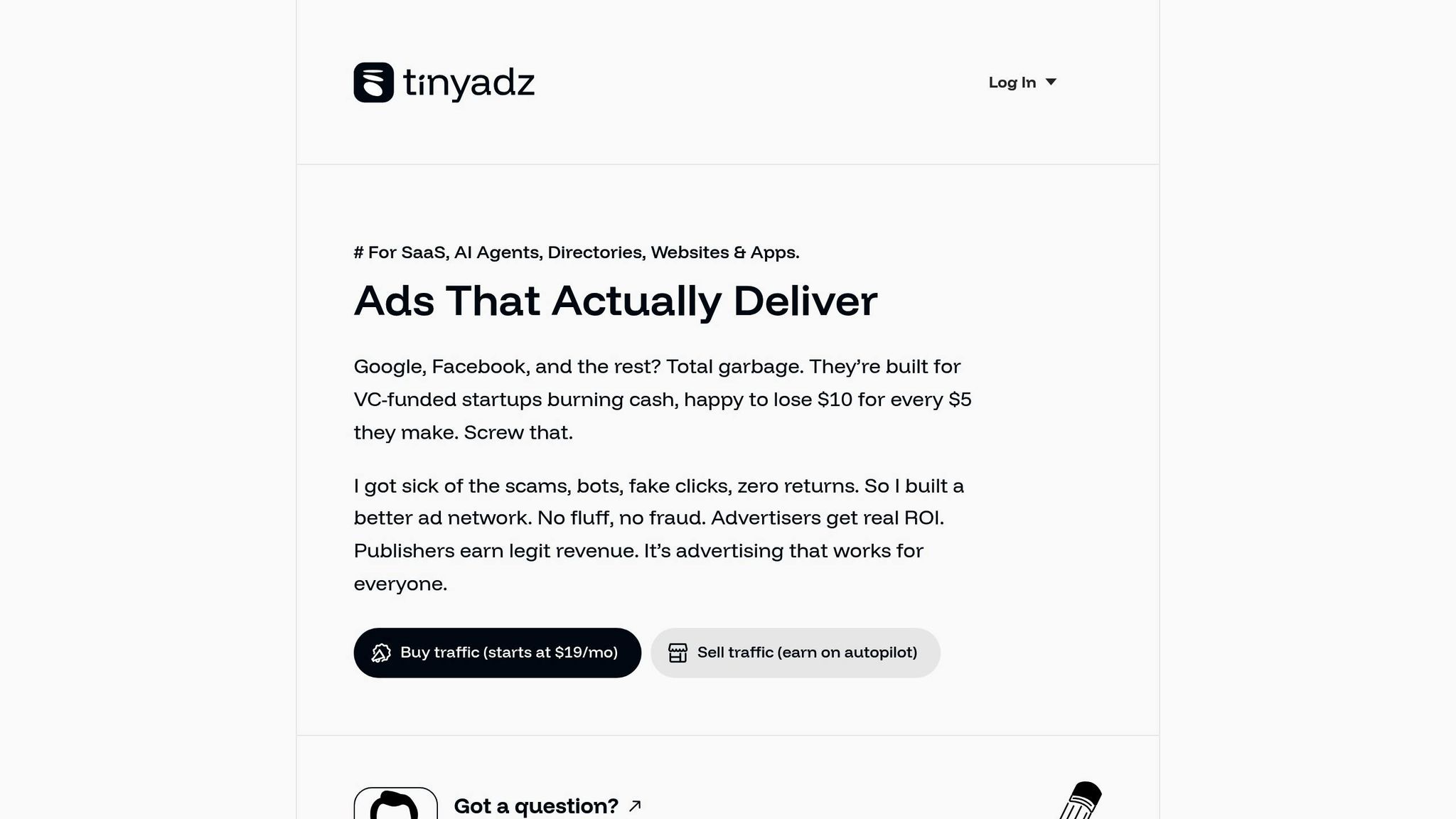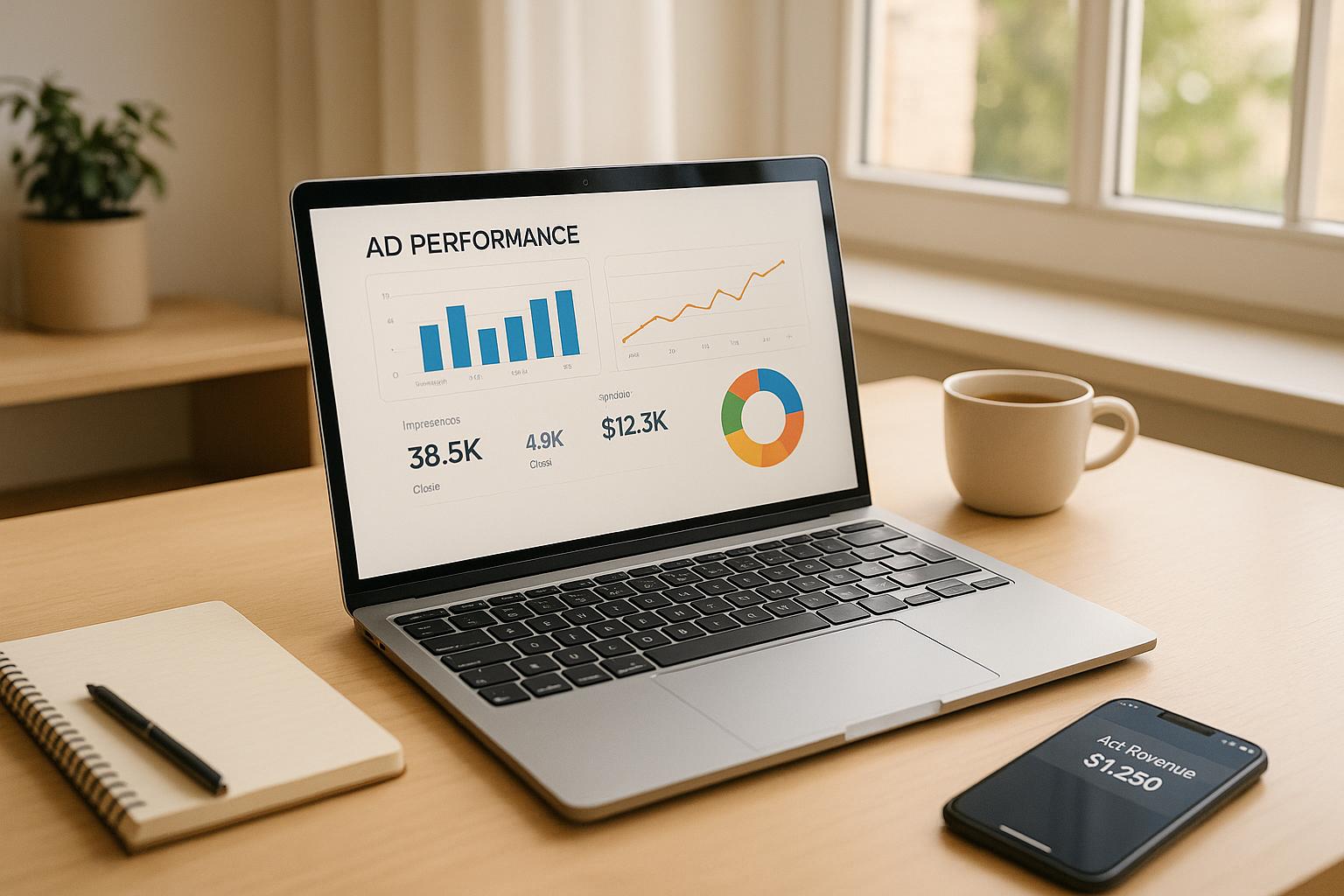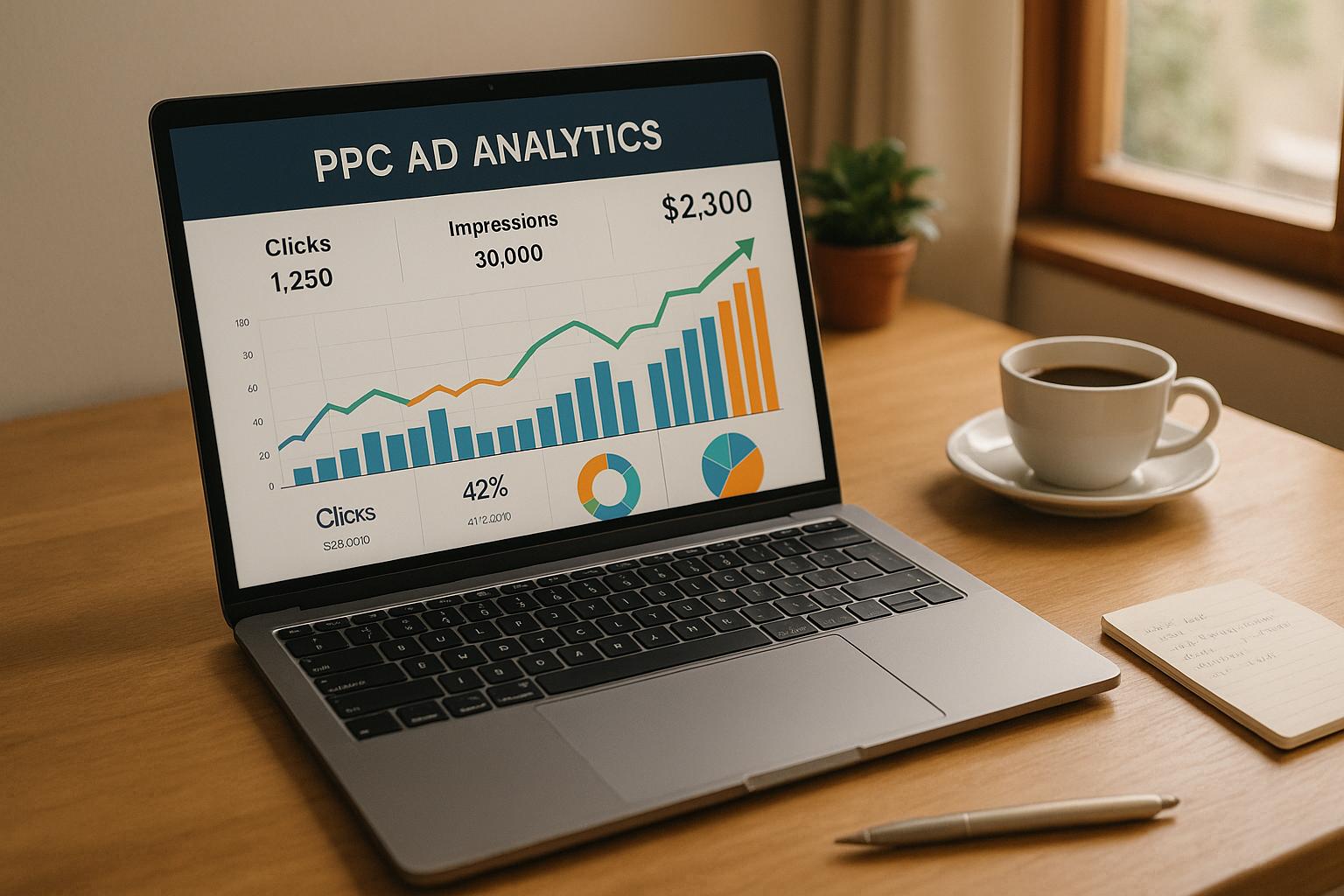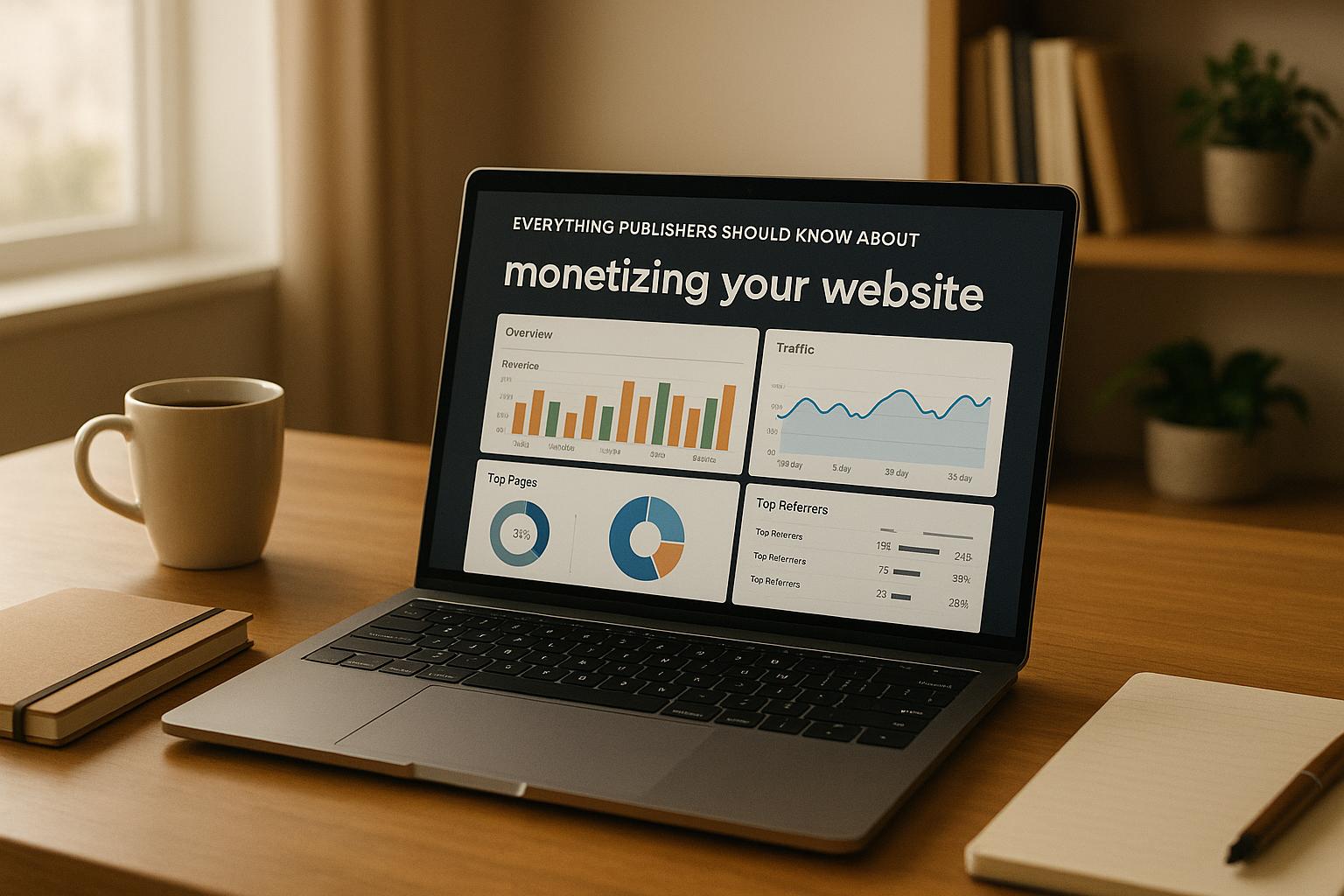Why Advertise Your Website?
- Visibility is key: 71% of users click results on the first page of Google, while the second page gets only 6%.
- Faster results than SEO: Advertising gives immediate traffic, while organic SEO can take months.
- Targeted audience: Ads let you reach specific groups based on demographics, interests, and behavior.
Key Advertising Channels
- Search Engine Ads (PPC): Pay only when someone clicks your ad. Great for quick, targeted traffic.
- Social Media Ads: Platforms like Facebook, Instagram, and TikTok let you target users by age, interest, and more.
- Display & Remarketing Ads: Use banners or retarget users who’ve visited your site to boost conversions.
How to Succeed
- Set clear goals: Define what you want - traffic, leads, or sales.
- Know your audience: Use targeting to reach the right people.
- Track ROI: Monitor performance and adjust campaigns for better results.
Budgeting Tips
- Start small and scale based on performance.
- Aim for a 3:1 return on ad spend (ROAS).
- Use tools like Google Analytics to track conversions.
Privacy Compliance
- Build first-party data (like email lists) to adapt to stricter privacy laws.
- Be transparent with users about data collection.
Quick Comparison of Advertising Channels
| Channel | Cost Range | Best For | ROI Potential |
|---|---|---|---|
| Search Engine (PPC) | $1–$7 per click | Targeted traffic, fast results | High |
| Social Media | $0.26–$1.20 per click | Brand awareness, younger audiences | Medium-High |
| Display/Remarketing | $0.50–$3 per CPM | Re-engaging past visitors | High |
Advertising your website is all about reaching the right audience, at the right time, with the right message. Start with small, targeted campaigns, measure your results, and adjust as needed to grow your traffic and conversions effectively.
Website Advertising Basics
What Website Advertising Is
Website advertising refers to paid promotional efforts aimed at driving traffic to a website and achieving specific business goals. It’s about delivering targeted messages to the right audience online.
"Advertising is any paid form of communication from an identified sponsor or source that draws attention to ideas, goods, services or the sponsor itself." – Lumen Learning
The primary goals of website advertising include building brand awareness, generating leads, and driving conversions. Brand awareness campaigns focus on introducing your brand to new audiences and increasing recognition in your industry. Lead generation campaigns gather contact information from potential customers, while conversion-focused efforts encourage immediate actions, such as making a purchase or signing up for a service.
What makes website advertising stand out from traditional methods is its cost efficiency and ability to track performance in real time. Unlike print or TV ads, which are limited by geography, online advertising has a global reach, giving businesses the opportunity to connect with audiences worldwide.
Key benefits of website advertising include its ability to expand reach, target specific audiences, measure success, and scale campaigns effectively. These advantages are particularly valuable in today’s fast-moving digital landscape.
Successful campaigns share a few essential ingredients: clear messaging, eye-catching visuals, and compelling calls-to-action.
Next, let’s explore how audience targeting takes these benefits to the next level.
Why Audience Targeting Matters
Building on the foundation of effective advertising, audience targeting ensures your message reaches the people most likely to respond. Instead of casting a wide net, targeting focuses on specific segments of the population based on factors like demographics, interests, behaviors, and preferences.
The financial impact of precise targeting is massive. For instance, segmentation can boost revenue by up to 760%. Additionally, 68% of consumers expect personalized experiences, and 82% of marketers agree that quality customer data is critical for success. On the flip side, poor targeting can lead to enormous waste - $5.6 billion of digital ad spend was wasted in 2022, with 23% of the $88 billion spent on ads being misallocated or poorly targeted.
Harvard Business School Professor Sunil Gupta explains the core challenge:
"While you can try and market a product to everyone, consumers have different needs and preferences. What appeals to one group of consumers may not appeal to another group."
By focusing on the most promising leads, effective targeting maximizes return on investment (ROI). It also helps businesses stand out from competitors, build long-term customer relationships, and avoid wasting resources on irrelevant campaigns.
Real-world examples highlight the power of targeting. During the 2008 financial crisis, McDonald’s shifted its marketing strategy to emphasize value and affordability. The company promoted its Dollar Menu and value meals through online platforms popular with its audience (Source: Harvard Business School Online, 2024). Similarly, GymShark, a fitness apparel brand, achieved record-breaking sales by partnering with athletic influencers who not only promoted the brand but also helped design and wear its products (Source: Harvard Business School Online, 2024).
The influence of targeted recommendations goes beyond direct advertising. Word of mouth drives 20% to 50% of all purchasing decisions. As Professor Gupta notes, 82% of people are likely to act on influencer recommendations, and 92% trust recommendations from people they follow on social media more than they trust traditional company advertisements.
To implement effective audience targeting, start by defining your ideal customer profile based on demographics, interests, behaviors, and purchasing habits. Conduct thorough market research to understand their needs, preferences, and challenges. Then, craft messages and content that resonate with this audience. Finally, monitor and analyze your campaign performance regularly, making adjustments based on your results and audience feedback.
Online Advertising: A Step-by-Step Guide
Main Advertising Channels
Using precise audience targeting, these channels help you connect with the right users at the perfect moment. Each one brings its own strengths, depending on your goals.
Search Engine Advertising (PPC)
Pay-per-click (PPC) advertising is a model where you pay only when someone clicks on your ad. Advertisers bid on keywords, platforms, and audience segments to determine the value of each click. It's a fast way to drive targeted traffic, especially when SEO efforts take longer to show results.
In 2022, PPC campaigns delivered an average return of $2 for every $1 spent, with the average cost per click (CPC) sitting at $1.16. To give some context, search ads accounted for 40% of ad spending in 2020, with 73% of that going to Google.
"PPC should be considered an asset, not a marketing expense."
PPC stands out for its precise targeting, real-time performance tracking, and cost efficiency compared to traditional advertising. It also boosts brand visibility - even if users don’t click - and complements your organic SEO strategy.
Getting started involves defining your audience, setting clear goals (like driving traffic, generating leads, or increasing sales), and researching relevant keywords. From there, craft compelling ad copy and choose platforms such as Google Ads, Microsoft Advertising, or Meta Ads. Regularly monitor and refine your campaigns to get the best results.
If connecting directly with your audience is a priority, social media advertising is another powerful option.
Social Media Advertising
Social media advertising allows businesses to pay for exposure to specific demographics across platforms, complementing organic efforts. In the U.S., social ad spending has grown by over 20% annually, with social video making up 52.5% of spending in 2023.
Consumers are increasingly integrating social media into their shopping habits. Two-thirds of shoppers use it as part of their buying journey, and one-third look to influencers for product recommendations. However, organic social engagement remains low, with just 0.07% of a page's fans typically interacting with posts.
Here’s a quick look at platform costs:
| Platform | Cost Range | Notes |
|---|---|---|
| $0.26–$0.50 per click | CPM: $1.01–$3.00 | |
| $0.50–$1.20 per click | CPC varies with destination URL | |
| Twitter/X | $0.26–$0.50 per click | Cost per follow: $1.01–$2.00 |
| TikTok | $0.50 minimum; CPM: ~$10 | |
| YouTube | $0.11–$0.50 per view | Video advertising |
| Snapchat | N/A | Average CPM: $3.03 |
Different platforms serve different purposes. For example, LinkedIn is ideal for B2B lead generation, TikTok excels with younger audiences, and Instagram and TikTok are particularly popular with Gen Z. Meanwhile, millennials are more active on Facebook [26, 29].
"The best platform yields the best results for your business, increasing the odds of engagement, conversions, and sales. Then, you can launch a paid social strategy that targets the right people at the right time." – Drew Pytel, Sr. Account Manager, KORTX
"You need to tailor your social media ads to your audience and the platform. The best social media managers spend time on these platforms, scrolling, interacting, and reading comments. This helps you understand the platform." – Kaylee Pope, Director of Content Strategy, KORTX
To succeed, create buyer personas, develop engaging content, and focus on video - 90% of marketers report strong ROI from branded videos. Start small, test different platforms and messages, and scale your budget as you learn what resonates with your audience.
If visuals are more your style, display and remarketing ads offer another way to connect.
Display and Remarketing Ads
Display ads use visuals like banners or videos to increase awareness, re-engage visitors, and drive conversions. Remarketing goes a step further by targeting users who’ve already interacted with your site.
Remarketing ads are particularly effective, achieving an average click-through rate (CTR) of 0.7% - ten times higher than the 0.07% CTR seen with standard display ads.
"Retargeting helps to reengage potential customers and get your offer in front of them again. This can have a big impact on sales, as the people being remarketed to have normally shown some form of commercial intent." – Joe Harulow, Founder, Sprint Creative
For industries like health and personal care, remarketing strategies accounted for 26% of total ad impressions.
Here are common remarketing approaches:
- Dynamic remarketing: Personalized ads based on products or services a user viewed.
- Remarketing Lists for Search Ads (RLSA): Custom search ads for past site visitors.
- Video remarketing: Targets users who interacted with your YouTube content.
- Email remarketing: Re-engages users based on their interactions with your emails.
"Remarketing is one of the most effective advertising techniques at the conversion level since we direct our efforts to users who have previously been in our store and, therefore, are interested in the products we sell." – Laura Aranda Rivera, Data Steward, Leadtech Group
To make the most of remarketing, segment your audience based on behavior (like pages visited or time spent on your site), tailor ad copy to match user interests, and set frequency caps to avoid overwhelming viewers. Incorporate clear calls-to-action and use A/B testing to refine your strategy. Remarketing not only drives conversions but also builds brand awareness, consideration, and loyalty.
sbb-itb-957fd63
Using TinyAdz for Targeted Advertising

TinyAdz takes a focused approach to advertising by prioritizing niche audience targeting over broad, generalized campaigns. Instead of casting a wide net like many advertising platforms, TinyAdz connects advertisers with verified publishers who cater to specific, well-defined audiences. This approach bridges the gap between businesses aiming to reach specialized markets and publishers seeking to monetize their content effectively.
How TinyAdz Connects Advertisers with Niche Publishers
TinyAdz excels at matching advertisers with publishers whose audiences align perfectly with their target demographics and interests. Unlike massive ad networks that focus on sheer volume, TinyAdz zeroes in on precision targeting. This allows businesses to engage with communities that are already interested in their industry, products, or services.
"Connect with real users on authentic niche platforms. Pinpoint the audiences that matter most." – TinyAdz
For advertisers, this means access to highly engaged audiences in specific industries or interest areas that are often hard to reach through traditional advertising channels. Publishers using TinyAdz have seen a 200% increase in advertiser renewals and have doubled their overall renewal rates. By focusing on these niche markets, advertisers can craft tailored messages that resonate deeply, leading to higher engagement and better results.
How Publishers Make Money with TinyAdz
TinyAdz offers publishers multiple ways to generate revenue, including banner ads, directories, social media, newsletters, and even events. The platform helps publishers deliver 10X more qualified leads while giving them full control over which ads appear on their platforms. Additionally, TinyAdz doesn’t impose traffic minimums, meaning publishers of all sizes can maximize earnings from their existing audiences.
TinyAdz Features: Verified Traffic and Clear Reporting
Beyond its monetization tools, TinyAdz ensures advertisers get high-quality traffic with 100% human impressions. This means advertisers only pay for real user interactions, safeguarding budgets from bot traffic or fake metrics. For publishers, this verification helps maintain trust and credibility with their advertising partners.
TinyAdz also simplifies performance tracking with clear, actionable reporting. The platform eliminates the need for overly complex dashboards, making it easy for advertisers and publishers to see how campaigns or earnings are performing.
"Drive engagement and maximize ROI in ways big ad networks can't match. See how your ads or earnings are doing with easy-to-understand stats." – TinyAdz
For advertisers running campaigns across multiple channels, TinyAdz supports UTM parameter integration to track traffic and conversions accurately. Using clean and consistent UTM formatting - such as lowercase letters and no spaces - ensures reliable data collection.
With its verified traffic, personalized ad placements, and transparent reporting, TinyAdz creates a space where advertisers and publishers can build long-term, performance-driven partnerships. This focus on genuine results helps both parties achieve sustainable success.
Managing Your Advertising Budget and ROI
Managing your advertising budget effectively is the difference between a campaign that brings in profits and one that wastes resources. To do this, you need clear goals, accurate tracking, and the flexibility to adapt to new privacy regulations. Budget management, ROI tracking, and staying privacy-compliant all go hand in hand to ensure long-term success in advertising. Here’s a closer look at how to approach these steps.
How to Set Realistic Budgets
Creating a realistic advertising budget starts with understanding your business metrics and setting achievable expectations. Begin by estimating key figures such as your monthly ad spend, expected cost-per-click (CPC), target conversion rate, average sale price, and lead-to-customer conversion rate.
For example, in B2B marketing, CPC can range from $1 to $7 or more, depending on your target audience and the ad platform. The average conversion rate for B2B campaigns hovers around 2.6%. A good starting point is to allocate about 10% of your total marketing budget to advertising and adjust based on performance. Tools like Google Keyword Planner can provide CPC estimates for search ads, helping you plan more effectively.
When setting your budget, focus on your expected return on ad spend (ROAS). A solid benchmark is a 3:1 ROAS, meaning every dollar spent should generate three dollars in revenue. This ratio can guide decisions on whether to increase spending on a high-performing campaign or make adjustments to underperforming ones.
Also, don’t overlook additional costs like creative development, personnel, agency fees, and overhead. These expenses should be factored into your total advertising investment to get a complete picture of your spending.
How to Track and Measure ROI
Tracking ROI isn’t just about crunching numbers - it’s about having the right systems in place to measure success accurately. Start by defining what counts as a conversion for your campaign. Whether it’s driving brand awareness, generating e-commerce sales, booking consultations, or securing free trial sign-ups, make sure you have a clear goal.
Use UTM codes to tag URLs and track traffic sources in Google Analytics. This allows you to pinpoint which campaigns are driving valuable traffic. Don’t forget to track phone calls, as offline conversions often stem from online advertising but are easily overlooked.
Here’s a quick breakdown of common ROI benchmarks:
| ROI Benchmark | Performance Level | Revenue Multiple |
|---|---|---|
| 2:1 | Break-even threshold | $2 for every $1 spent |
| 5:1 | Strong performance | $5 for every $1 spent |
| 10:1 | Exceptional results | $10 for every $1 spent |
A well-performing campaign might achieve a 5:1 ratio, delivering a 400% ROI, while exceptional campaigns can hit 10:1 ratios with a 900% ROI.
For more accurate insights, consider multi-touch attribution models instead of single-touch ones. These models capture the entire customer journey, giving you a better understanding of what’s driving results. CRM systems can also help you track leads from their first interaction all the way through the sales process. To stay on track, set SMART goals - specific, measurable, achievable, relevant, and time-bound - for each campaign.
While it’s tempting to focus on short-term metrics, don’t ignore long-term indicators like customer retention and lifetime value. These provide a fuller picture of your campaign’s impact. Regularly test ad copy and landing pages, segment audiences based on behavior, and use historical data to set performance benchmarks for each channel.
Staying Compliant with Privacy Changes
Privacy regulations are reshaping the advertising landscape. By 2025, eight more U.S. states will introduce privacy laws similar to the California Consumer Privacy Act (CCPA), putting stricter limits on data collection and tracking. Advertisers must adapt quickly to stay both compliant and effective.
For example, Apple’s 2021 privacy updates led to over 90% of iOS users opting out of third-party tracking. To navigate these changes, focus on building your first-party data. Add cookie banners to your website that meet GDPR and CCPA standards, grow your email subscriber list, and encourage customers to create accounts on your site. These strategies strengthen your direct relationship with customers, which is crucial as third-party data becomes harder to access.
Make sure your consent options for personalized advertising are clear and transparent. Update user consent flows to align with GDPR’s stricter rules, and consider using contextual targeting to deliver relevant ads without relying on sensitive personal data. This approach keeps your ads effective while respecting user privacy.
Data minimization is another emerging standard. For instance, Maryland’s privacy law requires data collection to be limited to what is “reasonably necessary and proportionate”. Apply this principle across your campaigns by collecting only the data you truly need to achieve your goals.
Finally, explore privacy-first ad technologies that protect user data without compromising campaign performance. Develop localized data processing solutions to comply with regional laws, and update your privacy policies regularly as new regulations come into effect.
The shift toward privacy-first strategies doesn’t mean giving up on effective advertising. Instead, it’s about evolving your approach to create campaigns that respect user privacy while delivering strong results.
Conclusion: Key Points for Website Advertising Success
Success in website advertising hinges on careful planning, smartly chosen tools, and data-driven strategies. When these elements come together, they pave the way for campaigns that deliver results without overspending.
Budgeting and audience targeting are the backbone of any effective campaign. A clear budget, combined with a deep understanding of your audience, ensures that resources are used wisely. With 71% of customers expecting tailored content and 76% feeling frustrated when they don’t get it, generic ads are no longer an option.
The right tools make all the difference. Platforms like TinyAdz offer features like verified traffic and personalized targeting that go beyond what traditional methods provide. Tools that support keyword research, bid management, performance tracking, A/B testing, and budget control are essential for maximizing results.
Focusing on ROI is what separates successful advertisers from those who overspend. Data-driven approaches are shown to triple decision-making effectiveness. This means using tactics like dynamic creative optimization, testing different ad formats, and setting frequency caps. With the programmatic advertising market expected to exceed $247 billion in the U.S. by 2024, those who embrace real-time data and machine learning will stay ahead.
As privacy regulations evolve, advertisers must remain flexible while sticking to the basics: knowing their audience, allocating resources wisely, and refining performance. Whether you’re launching your first campaign or scaling up, these principles can lead to sustainable growth and measurable business success.
FAQs
How can I effectively target the right audience with my website ads?
To connect with the right audience, begin by identifying distinct audience groups based on demographics, interests, and online habits. Leverage data-driven tools to fine-tune your targeting, but avoid being overly specific, as this could restrict your reach.
Explore a mix of advertising platforms - social media, search engines, and display networks - to create a well-rounded, omnichannel presence. Continuously monitor your campaign performance, making adjustments as needed to boost engagement and get the most out of your investment.
How can I track the success of my advertising campaigns and ensure a strong ROI?
To measure how well your advertising campaigns are performing and to ensure you're getting a strong return on investment (ROI), it’s essential to track a few key metrics. These include sales growth, return on ad spend (ROAS), conversion rates, customer lifetime value (CLV), and click-through rates (CTR). Keeping an eye on these numbers gives you a clear picture of how effectively your campaigns are delivering results.
Calculating ROI is straightforward: divide the net profit your campaign generates by its total cost. If the result is positive, your campaign is on the right track. Beyond that, analytics tools can help pinpoint which channels are driving the most revenue. This insight lets you adjust your budget and strategies to focus on what works best. Regularly reviewing these metrics allows you to fine-tune your campaigns and improve your overall outcomes.
How can I make sure my website advertising complies with US privacy laws?
To make sure your website advertising aligns with US privacy laws, start by being upfront about how you collect data. Use clear and straightforward cookie consent banners that explain what data is being collected and why. It’s also a good idea to regularly review and update your privacy policy to account for changes in regulations, such as COPPA or new state-level laws.
On top of that, conduct regular risk assessments to spot any compliance gaps and keep a record of the steps you’re taking to safeguard user data. Stay on top of updates to both federal and state laws, and tweak your advertising strategies as needed to ensure you’re always following the rules.


